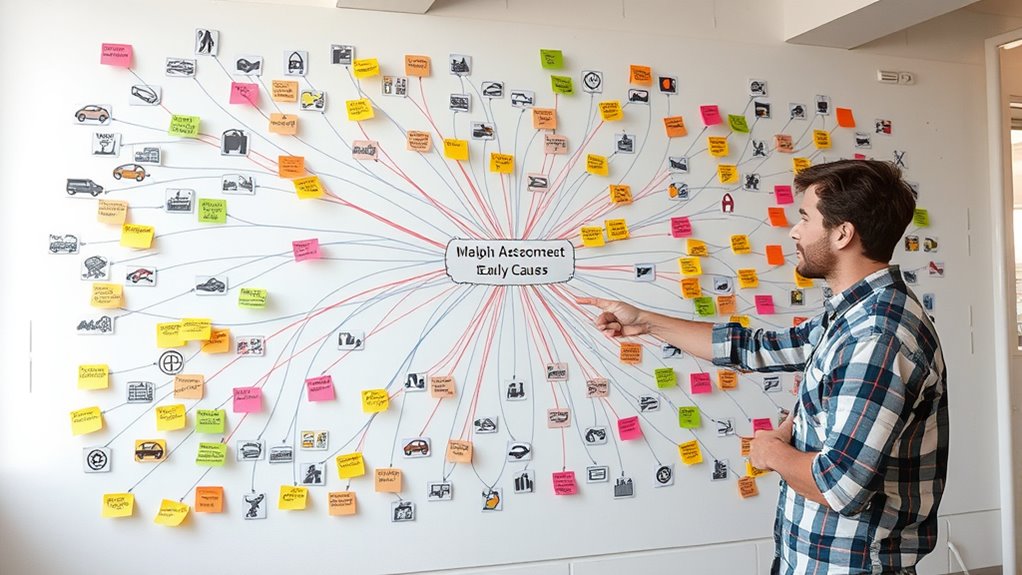Systems thinking helps you tackle everyday problems by showing how different parts of a situation are interconnected and influence each other. You can identify feedback loops, observe patterns, and understand root causes rather than just addressing symptoms. By mapping these interactions, you’ll see opportunities for small changes that produce big impacts. Developing this mindset helps you make more thoughtful, sustainable decisions. Keep exploring how to apply these ideas to your challenges for smarter solutions.
Key Takeaways
- Identify system boundaries and components to understand how various parts influence each other in daily problems.
- Recognize feedback loops that reinforce or balance behaviors affecting your situation.
- Map relationships and causal links to uncover root causes behind symptoms.
- Focus on leverage points where small changes can lead to significant improvements.
- Anticipate unintended consequences by analyzing systemic interactions before implementing solutions.
Understanding the Basics of Systems Thinking

To grasp systems thinking, you need to see beyond individual parts and recognize how they interact within a whole. It involves understanding system boundaries—defining what’s included and what’s outside the system—and how these boundaries influence your perspective. Feedback loops are core to this approach; they show how outputs of a process circle back as inputs, creating reinforcing or balancing effects. Recognizing these loops helps you understand stability or change within the system. Instead of viewing problems in isolation, you see how components influence each other over time. This holistic view enables you to identify leverage points and anticipate unintended consequences. By mastering these basics—system boundaries and feedback loops—you set a solid foundation for deeper analysis and effective problem solving. Additionally, understanding forsale 100 can offer insights into market dynamics that influence systemic behavior.
Recognizing Interconnections in Daily Life

Recognizing interconnections in daily life means seeing how different actions and events influence each other within your environment. These connections often form feedback loops, where outcomes loop back to affect earlier parts, reinforcing or balancing behaviors. For example, your habits can create emergence phenomena—unexpected patterns that arise from simple interactions. By observing these, you realize how small changes ripple through systems. Understanding feedback mechanisms can help you anticipate the effects of your actions more effectively.
Mapping Systems to Identify Root Causes

Mapping systems to identify root causes involves analyzing how different components interact within a problem. You’ll use tools like causal diagrams to visualize relationships and spot feedback loops that sustain issues. These diagrams help you trace back to the core causes, rather than just addressing symptoms. Incorporating predictive modeling can further refine your understanding by forecasting future outcomes based on current interactions.
Applying Systems Thinking to Common Challenges

Applying systems thinking to common challenges allows you to see beyond immediate problems and understand the underlying structures that cause them. By examining feedback loops, you can identify how certain actions reinforce or counteract issues, revealing patterns that influence outcomes over time. Recognizing causal relationships helps you see how different parts of a system interact, often creating unintended consequences. For example, a new policy might temporarily reduce a problem, but a feedback loop could eventually worsen it. Understanding these connections enables you to design more effective solutions that address root causes rather than just symptoms. Incorporating well-being tips into your approach can further enhance your ability to develop sustainable improvements in everyday challenges. With this perspective, you’re better equipped to identify leverage points and implement changes that lead to sustainable improvements in everyday challenges.
Building a Systems Mindset for Better Decision-Making

How can you develop a systems mindset that enhances your decision-making? First, recognize the importance of feedback loops—both reinforcing and balancing—that influence outcomes over time. Second, identify leverage points within your system where small changes can lead to significant improvements. Third, practice seeing the big picture by mapping out how different elements interact, rather than focusing on isolated parts. This approach helps you anticipate unintended consequences and adjust strategies proactively. Cultivating this mindset requires curiosity and patience, but it makes your decisions more effective and sustainable. Additionally, understanding the concept of digital literacy can help you integrate technology effectively into problem-solving. By understanding feedback loops and leverage points, you gain the ability to influence systems thoughtfully, leading to smarter choices and better results in everyday problems.
Frequently Asked Questions
How Can I Start Practicing Systems Thinking in My Daily Routine?
To start practicing in your daily routine, focus on adopting a holistic approach to problems. Begin with simple everyday exercises, like observing how different actions affect your day or noticing patterns in your environment. Ask yourself questions about how various parts connect and influence each other. Over time, these small steps will help you develop a systems thinking mindset, making it easier to see the bigger picture in everyday situations.
What Are Common Mistakes to Avoid When Applying Systems Thinking?
You might think avoiding mistaken assumptions and oversimplified models is obvious, but it’s easy to fall into these traps. When applying systems thinking, don’t ignore the complexity—think you’ve got all the pieces figured out. Instead, challenge your assumptions, dig deeper, and resist the urge to oversimplify. Recognize that real systems are messy, and staying open-minded helps you see the bigger picture without jumping to quick conclusions.
How Does Systems Thinking Differ From Linear Problem-Solving Approaches?
When you compare systems thinking to linear problem-solving, you see it focuses on understanding causal loops and feedback mechanisms, which reveal how different parts of a system influence each other over time. Unlike linear approaches that address problems step-by-step, systems thinking encourages you to see the bigger picture, recognizing patterns and interconnections that help you identify root causes and long-term solutions rather than just immediate fixes.
Can Systems Thinking Improve Long-Term Planning and Goal Setting?
Yes, systems thinking can improve your long-term planning and goal setting by helping you adopt a holistic perspective. You’ll see how interconnected systems influence each other over time, allowing you to anticipate potential challenges and opportunities. Instead of focusing on isolated issues, you consider the bigger picture, which leads to more sustainable and adaptable plans. This approach enables you to set realistic goals aligned with the complex dynamics of the systems involved.
What Tools or Resources Are Recommended for Beginners to Learn Systems Thinking?
Imagine opening a secret map to solving complex puzzles! For beginners, start with simple tools like causal loop diagrams and feedback analysis to visualize how parts of a system interact. Books like “Thinking in Systems” by Donella Meadows and online courses on platforms like Coursera or Udemy can guide you step-by-step. These resources make mastering systems thinking approachable, helping you see the bigger picture and solve problems more effectively.
Conclusion
By embracing systems thinking in your daily life, you can see the bigger picture and uncover root causes more effectively. Recognize the interconnections around you and approach challenges with a systems mindset. Remember, “A chain is only as strong as its weakest link,” so strengthening your understanding of the whole helps you solve problems more wisely. With practice, you’ll make smarter decisions and navigate life’s complexities with greater confidence.









